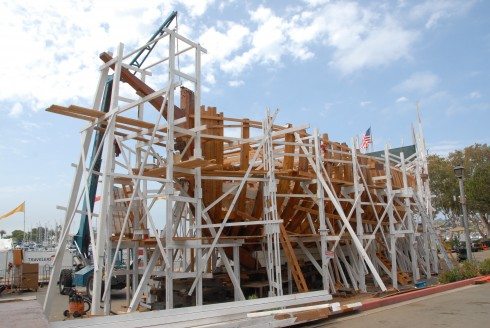History Afloat: The Voyage of the San Salvador Replica

Four hundred and seventy-four years after the Spanish explorer Juan Rodriguez Cabrillo became the first European to describe San Diego Bay, a replica of his flagship galleon, the San Salvador, is launching from those same waters on a commemorative voyage.
The gorgeous replica tallship’s “Pacific Heritage Tour,” an initiative of the Maritime Museum of San Diego, will offer a pretty amazing opportunity to reflect upon the history of California—and it all kicks off this Labor Day Weekend during the Maritime Museum’s “Festival of Sail.”
Come stay with us at the Sofia Hotel and take in the San Salvador—completed in 2015 after years of painstaking work—as she joins other vintage and reproduced ships in the Parade of Sail on September 2. The galleon will be visible during the rest of the festival (September 3 through 5) before setting off on a remarkable Pacific voyage.
The Story of the San Salvador
Built by Cabrillo himself, the San Salvador led his small fleet when he left Navidad, Mexico in June of 1542 to explore the Pacific coast north of New Spain. This was one of two exploratory expeditions launched by the Viceroy of New Spain to scout trade routes; the other, headed by Ruy Lopez de Villalobos, beelined for the Philippines, but its crew ultimately mutinied and killed Villalobos.
Cabrillo made it to present-day Southern California some three months after leaving Navidad, and described San Diego Bay, which he named San Miguel Bay, as “a very good enclosed port.” It’s believed he anchored the San Salvador off the eastern shore of Point Loma and made landfall at Ballast Point.
After eyeballing San Diego Bay, Cabrillo and his men headed north: They chronicled Monterey Bay (but missed San Francisco Bay), and may have turned around in the vicinity of Point Reyes. Cabrillo may have escaped the mutinous fate of his counterpart, Villalobos, but he still didn’t live to see his expedition concluded: While wintering in the Channel Islands, he injured his leg in a confrontation with the Tongva Indians, and died on January 3, 1543, after it became infected.
His crew subsequently went northward again and may have poked around as far as the mouth of the Rogue River on the southern Oregon coast before retreating from rough winter storms and returning to Mexico.
(If you’re a history buff, incidentally, Cabrillo National Monument on the Point Loma Peninsula, which encompasses part of the San Diego geography Cabrillo investigated, is a must-visit.)
The Pacific Heritage Tour
After departing San Diego, the San Salvador replica will trace Cabrillo’s journey with ports-of-call at Oxnard’s Channel Islands Maritime Museum (September 15 through 18), the Monterey Bay State Historic Park (September 23 through 25), and Morro Bay’s Central Coastal Maritime Museum Association (September 30 through October 9).
You can even buy tickets to sail aboard the San Salvador on three different stretches of its homeward trek: (1) Morro Bay-Channel Islands-Oxnard between October 10 and 14; (2) a Catalina Island circumnavigation between October 17 and 21; or (3) Catalina-San Diego between October 23 and 26.
Don’t miss the chance to see the San Salvador on its throwback odyssey!

